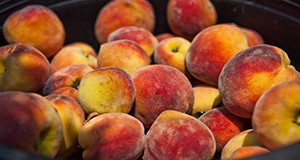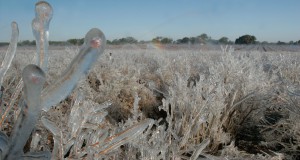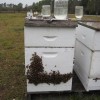A chilling temperature is any temperature that is cold enough to cause plant injury but not cold enough to freeze the plant. Chilling injury can occur to tropical foliage plants if greenhouses become too cold or if plants are exposed to chilling temperatures outside of the greenhouse during packing and shipping. Dieffenbachia, commonly known as dumb cane, ranks among the top five most popular foliage plant genera produced and sold in the United States. This four-page fact sheet describes the chilling temperatures of Dieffenbachia cultivars in order to assist growers to better manage greenhouse temperatures. Written by Jianjun Chen and published by the Environmental Horticulture Department.
http://edis.ifas.ufl.edu/ep530
Tag: Cold Protection and Chilling Damage
Frost Protection Irrigation for Florida Peaches: Economic Considerations

Peach production in Florida is increasing in importance, and the peach industry is growing rapidly in the state, where the early harvest and early market window allow the prices for Florida peaches to be high compared to those received by producers in the other southeastern states. Reduction in peach production costs would allow Florida peach producers to increase their net revenues. This 7-page fact sheet describes a strategy for limiting water use for frost protection of peach trees in the winter to reduce producers’ costs, protect lakes and streams, and reinforce the public image of farmers as innovators and environmental stewards. Written by Tori Bradley, Tatiana Borisova, and Mercy Olmstead and published by the Food and Resource Economics Department.
edis.ifas.ufl.edu/fe980
Improving the Precision of Blueberry Frost Protection Irrigation

In Florida, early-ripening southern highbush blueberry cultivars allow growers to take advantage of high prices in the early market before other states can compete with higher volumes of berries sold at lower prices. That advantage comes with a vulnerability, however, because frosts can reduce gains. Florida growers rely on strategies like cold protection irrigation to reduce their risk of loss due to cold damage. This 9-page article by Tatiana Borisova, Tori Bradley, Mercy Olmstead, and Jeffrey Williamson describes a UF/IFAS study comparing precision cold protection irrigation to uniform cold protection irrigation to estimate the potential savings in diesel costs and water withdrawal volumes associated with the two practices and help protect Florida’s valuable and vulnerable blueberry harvest. Published by the Food and Resource Economics Department in November 2015.
http://edis.ifas.ufl.edu/fe979
Overwintering Honey Bee Colonies in Northern Climates
 One of the many challenges beekeepers face is minimizing honey bee colony losses during winter. This can be especially challenging to beekeepers in extreme northerly climates. Special preparations must be made during the fall to ensure that colonies survive the winter months with minimal loss. This 3-page fact sheet was written by James D. Ellis and Katherine Hammons, and published by the UF Department of Entomology and Nematology, September 2013.
One of the many challenges beekeepers face is minimizing honey bee colony losses during winter. This can be especially challenging to beekeepers in extreme northerly climates. Special preparations must be made during the fall to ensure that colonies survive the winter months with minimal loss. This 3-page fact sheet was written by James D. Ellis and Katherine Hammons, and published by the UF Department of Entomology and Nematology, September 2013.
http://edis.ifas.ufl.edu/in1006
Protecting Blueberries from Freezes in Florida (HS968/HS216)
 Blueberry growers: know when the conditions are right in commercial blueberry fields, during and after bloom, for freeze damage, as well as practices you can use to minimize it. This 7-page fact sheet was written by J.G. Williamson, P.M. Lyrene, and J.W. Olmstead, and published by the UF Department of Horticultural Sciences, January 2012.
Blueberry growers: know when the conditions are right in commercial blueberry fields, during and after bloom, for freeze damage, as well as practices you can use to minimize it. This 7-page fact sheet was written by J.G. Williamson, P.M. Lyrene, and J.W. Olmstead, and published by the UF Department of Horticultural Sciences, January 2012.
http://edis.ifas.ufl.edu/hs216
ENH92/MG318 Cold Damage on Palms
Revised! ENH921, a 6-page illustrated fact sheet by Timothy K. Broschat, describes how cold temperatures affect palms and how to treat them following a cold weather event. Includes references. Published by the UF Department of Environmental Horticulture, September 2010.
http://edis.ifas.ufl.edu/mg318
ENH1168/EP429 Cold Protection of Foliage Plants in Shadehouses and Greenhouses
ENH1168, a 10-page illustrated fact sheet by Robert H. Stamps, Jianjun Chen, Seenivasan Natarajan, and Lawrence R. Parsons, informs ornamental foliage plant growers about various cold protection measures that can be adopted before and during cold events to avoid or minimize losses due to chilling or cold injury. Includes glossary and references. Published by the UF Department of Environmental Horticulture, July 2010.
http://edis.ifas.ufl.edu/ep429
